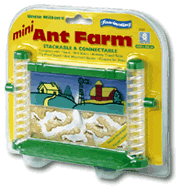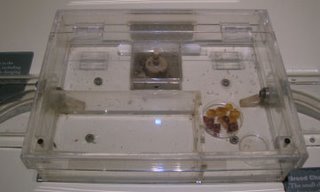Farming Ants

When you think of keeping ants indoors, you probably think of an "ant farm" arrangement, with a thin layer of soil between two sheets of glass or plastic. Perhaps you even had one. Worker ants are placed in the ant farm, and they create tunnels and galleries in the soil. Museums and insect zoos still use this kind of display for their ants. It’s affectionately referred to as an Uncle Milton display, after the manufacturer who for decades has sold the toy versions.
There are some limitations to the Uncle Milton style display. Even with a very thin layer of soil, the ants are really good at hiding, so it’s hard to see a lot of the interesting activities. Moreover, the most interesting ant activities can never be seen in the version of the kit that you can buy in a toy store. The kit contains all of the materials for the ant farm, plus a mail-in coupon for the ants. When your package arrives, you get worker ants only- no queen, no brood, and none of the most interesting ant behavior.
In the late 1990’s the Sonoran Arthropod Studies Institute (SASI) in Tucson developed a completely new kind of ant display. This display contains no soil at all. It’s a series of Plexiglas boxes connected by flexible plastic tubes. All of the ant activities are in full view. We have maintained such a display since 2001. The live ant colonies are not cheap. They are very unpleasant to collect (more on that shortly), and it can take a long time to build up a robust colony with lots of workers. A good colony can cost several hundred dollars.

The Nature Museum's ant display
We have maintained a SASI style ant colony at the Nature Museum since 2001. It’s always a popular exhibit. Unfortunately, a little over a year ago, the colony was vandalized. A visitor took a knife or a razor and slashed through the flexible plastic tubing. We managed to get the situation under control, but had to kill a substantial number of workers in the process. The queen survived, but the colony has only had a fraction of the number of workers present before the vandalism, and is just beginning to recover.

Closeup of the brood chamber
While at the SASI conference in Tucson last summer, a member of my staff and I collected several new queens to start backup colonies with. This is a good time to collect spine-waisted ants, the species that we are working with, because this is when new queens mate and begin laying eggs. The summer rains stimulate the alalte (winged) members of ant colonies to take flight and mate. At the end of these nuptial flights, their mates bite off the new queens’ wings, and they settle down to begin new colonies. As queens of this species can live for 10-15 years, there is excellent potential for a very long lifetime if you gather them at this time.

Vincent digging into an ant mound
I had thought that the queens would be the hardest, though most vital, part of the colony to get. I had visions of digging into an ant mound and sifting through thousands of biting ants to find the queen- the only member of the colony who can lay eggs and produce new workers. I was wrong. Newly-mated queens don’t tunnel. We found dozens of them in a pasture under cow patties. We tried to collect brood to "boost" the colonies, including our own beleaguered queen back in Chicago. To do this we dug into several spine-waisted ant mounds that we found in the same pasture.

Vincent gets "up-close and personal" with the ants
Collecting brood is not fun. The ground in the pasture was almost rock hard and both we and the ants were only able to dig in a few inches. We had been hoping to dig into brood chambers, where hundreds of grub-like juvenile ants would be found. Alas, the ants here scattered their brood about, and we could only find a few grubs here and there. Meanwhile, we were attacked by thousands of very angry worker ants defending the nests. I was only minimally attacked, because I was doing the all-important photo documentation (it’s great to be boss). Vincent, my assistant, eventually removed his shoes and socks because he found it easier to deal with the ants barefoot.

Ant brood. A pathetically small quantity.
Today, we have two healthy new queens. They are producing brood, and the first of these have become worker ants. It will probably take quite some time to build up sufficient numbers to make a good display, but at least we now have backup colonies should something else happen to our ant exhibit.

One of our new queens with brood


1 Comments:
wow, even ant farms go high tech in the 21st century.
If you are taking requests, I would like to hear somethings about beetles some day.
Post a Comment
<< Home